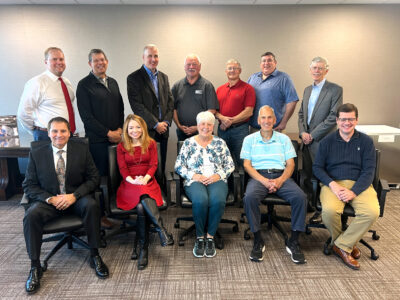Opportunities highlight DeWine’s 2025 State of the State address
COLUMBUS — As Gov. Mike DeWine delivered his 2025 State of the State address Wednesday, he focused largely on creating educational and economic opportunities and cited success stories from across the state.
During a joint session of the Ohio General Assembly, DeWine touted targeted efforts to attract economic development projects that have added more than 81,000 private sector jobs and said at least 15,000 additional jobs are coming to the Buckeye State through projects that are in development.
In particular, he pointed to Jefferson County, where he said JSW Steel will be adding 42 new jobs and retaining hundreds more as it upgrades the Mingo Junction steel plant to produce cleaner and higher quality specialty steel.
DeWine also talked about the need to include Ohioans with disabilities in the state’s workforce. He said the state agency Opportunities for Ohioans with Disabilities has helped almost 32,000 Ohioans with disabilities reach their goal of employment under his administration. Among those individuals is Kelsi Weaver, who is originally from Martins Ferry and has spastic quadriplegic cerebral palsy. DeWine said O-O-D provided her with essential career assessments, assistive technology and job readiness training, enabling her to complete her college degree and pursue her passion for helping others. Today she lives in Waterville in Lucas County and works as a social worker at Clearwater Council of Governments.
DeWine announced that Lt. Gov. Jim Tressel will lead an initiative to implement Ohio’s Workforce Playbook. By examining the needs and circumstances of Ohio’s various regions, he said Ohio’s Workforce Playbook will determine a course of action to retain existing talent, recruit new talent and rally Ohio’s existing workforce to greater productivity.
Speaking before a crowd of legislators and members of the public, DeWine pledged to continue making Ohio the best place in the nation to live, work and raise a family.
“Since taking office, my administration has worked each day to help ensure that every Ohioan has the tools to live up to their full potential and the opportunity to live their version of the American dream,” DeWine said. “For the truth is, we cannot achieve our full potential as a state unless each Ohioan first achieves theirs.”
As he broached the topic of education, DeWine again called for a ban on cellphones in all Ohio schools.
Following enactment of a new law last year requiring school districts to implement policies to address the use of cellphones in schools, DeWine said, many districts that banned cellphones have noted substantial improvement in student engagement, attendance, grades, socialization and communication.
“Addiction to screen time and the non-stop barrage of notifications rob our children of precious time to learn from their teachers during the school day,” DeWine said. “I ask the Legislature to approve the language in our budget to put an end to cellphone use during school hours in all Ohio school districts to give the precious time during the school day back to our kids so they can learn and teachers can teach.”
Also on the topic of education, DeWine said Ohio’s recent shift to implement the Science of Reading in all K-12 schools is delivering encouraging results. This year’s School Report Cards showed significant improvement in English language arts proficiency among elementary students, climbing by 2.2 percent among Ohio third-graders, 5.2 percent among fourth-graders and 3.1 percent among fifth-graders. To recognize and celebrate schools that are improving literacy instruction, DeWine announced the creation of the new Governor’s Science of Reading Recognition Program. More than 40 schools have been selected for this recognition in the program’s inaugural year, and DeWine said the full list of schools will be announced soon.
To better incorporate several subjects into the curriculum of Ohio’s schools, DeWine also announced plans to:
• Embed social studies content directly into materials used to teach reading and writing skills.
• Require instruction on Ohio history in every grade, starting in kindergarten.
• Emphasize the development of essential practical life skills such as time management, problem-solving, teamwork, critical thinking, and adaptability.
• Integrate career planning into existing high school graduation plans to help students define their career goals and identify the education or training needed to achieve them.
• Put driver’s education back into Ohio’s high schools.
DeWine also announced plans for two new school programs:
The Ohio Principal Apprenticeship Program will match aspiring principals with veteran principals to better prepare them to embrace the challenges of school leadership.
Tressel will lead a soon-to-be-announced initiative to promote physical fitness in Ohio schools.
Meanwhile, DeWine said Ohio continues to help more working families get financial support for childcare. Ten months after the launch of Ohio’s Childcare Choice Voucher Program, which expanded access to state childcare support to assist working families earning up to 200 percent of the federal poverty level, Ohio is now supporting 5,100 more families and 7,700 more children.
Additionally, DeWine’s proposed child tax credit would provide families up to $1,000 per child every year through age 6.
The governor noted that programs in Ohio that offer school-based care are successfully helping students thrive. He announced details of two new school-based programs proposed in the state budget:
The OhioSEE vision program would ensure that all Ohio students in kindergarten through third grade get vision screenings. Further, the program will ensure all students who need follow-up comprehensive eye exams or glasses get them. An anticipated 33,000 children are expected to be served by OhioSEE during the next two years.
The Children’s Dental Services Program will start as a pilot program in nine Ohio counties that are designated as Dental Health Professional Shortage Areas and lack nonprofit dental facilities to provide care to low-income families. The program will partner with dental professionals in the community and school districts to deploy dental programs directly into schools — providing screenings, preventive care, and treatment to children who need these services the most.
State Rep. Ron Ferguson, R-Wintersville, appreciated DeWine’s acknowledgement of the local region and his focus on workforce issues.
“The Ohio Valley was a focal point of the State of the State,” Ferguson said via email Wednesday evening. “It was nice to hear Belmont and Jefferson counties specially mentioned, especially about building our local workforce.”
State Sen. Brian Chavez, R-Marietta, said DeWine delivered a good message overall and that it was nice to see success stories highlighted from various parts of the state. He said he is concerned, however, that the many good ideas the governor presented are initiatives that will need to be funded.
“I think we need more than just good ideas, we need a good plan,” said Chavez, who is vice chair of the Senate Finance Committee. “I was just looking through the transportation budget and all the money we spend on previous good ideas. What will we have to cut to fund the next good idea? “I appreciate what he is trying to do, but a lot of these initiatives are going to cost money, and we have to figure out how to fund them. We want successes for everyone. That’s why we need an overall plan.”



